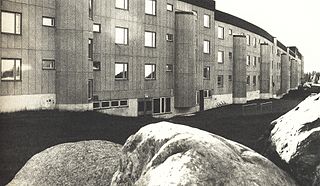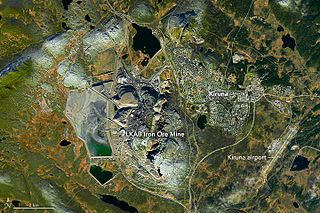Related Research Articles

Conglomerate is a sedimentary rock made up of rounded gravel-sized pieces of rock surrounded by finer-grained sediments. The larger fragments within conglomerate are called clasts, while the finer sediment surrounding the clasts is called the matrix. The clasts and matrix are typically cemented by calcium carbonate, iron oxide, silica, or hardened clay.

Ringing rocks, also known as sonorous rocks or lithophonic rocks, are rocks that resonate like a bell when struck. Examples include the Musical Stones of Skiddaw in the English Lake District; the stones in Ringing Rocks Park, in Upper Black Eddy, Bucks County, Pennsylvania; the Ringing Rocks of Kiandra, New South Wales; and the Bell Rock Range of Western Australia. Ringing rocks are used in idiophonic musical instruments called lithophones.

Grängesberg is a locality situated in Ludvika Municipality, Dalarna County, Sweden, with 3,481 inhabitants in 2010.

Svappavaara is a locality situated in Kiruna Municipality, Norrbotten County, Sweden with 417 inhabitants in 2010. It is a mining village. Mining was started around 1650. Large scale iron mining started in 1965. The mine was closed in 1983, but enrichment of iron ore from the mine at Kiruna is still going on. The mine is owned by LKAB, and there is an ongoing project to open it again for production around year 2015.
Iron oxide copper gold ore deposits (IOCG) are important and highly valuable concentrations of copper, gold and uranium ores hosted within iron oxide dominant gangue assemblages which share a common genetic origin.

The Kiruna mine is the largest and most modern underground iron ore mine in the world. The mine is located in Kiruna in Norrbotten County, Lapland, Sweden. The mine is owned by Luossavaara-Kiirunavaara AB (LKAB), a large Swedish mining company. In 2018 the mine produced 26.9 million tonnes of iron ore. The Kiruna mine has an ore body which is 4 km (2.5 mi) long, 80 metres (260 ft) to 120 metres (390 ft) thick and reaching a depth of up to 2 km (1.2 mi). Since mining began at the site in 1898, the mine has produced over 950 million tonnes of ore. As of 2020, the main haulage level is 1,365 m below the ore outcrop at Kiirunavaara that existed prior to mining.

The Atacama Fault Zone (AFZ) is an extensive system of faults cutting across the Chilean Coastal Cordillera in Northern Chile between the Andean Mountain range and the Pacific Ocean. The fault system is North-South striking and runs for more than 1100 km North and up to 50 km in width through the Andean forearc region. The zone is a direct result of the ongoing subduction of the Eastward moving Nazca Plate beneath the South American Plate and is believed to have formed in the Early Jurassic during the beginnings of the Andean orogeny. The zone can be split into 3 regions: the North, Central and South.

El Laco is a volcanic complex in the Antofagasta Region of Chile. It is directly south of the Cordón de Puntas Negras volcanic chain. Part of the Central Volcanic Zone of the Andes, it is a group of seven stratovolcanoes and a caldera. It is about two million years old. The main summit of the volcano is a lava dome called Pico Laco, which is variously reported to be 5,325 metres (17,470 ft) or 5,472 metres (17,953 ft) high. The edifice has been affected by glaciation, and some reports indicate that it is still fumarolically active.

The Fig Tree Formation, also called Fig Tree Group, is a stromatolite-containing geological formation in South Africa. The rock contains fossils of microscopic life forms of about 3.26 billion years old. Identified organisms include the bacterium Eobacterium isolatum and the algae-like Archaeosphaeroides barbertonensis. The fossils in the Fig Tree Formation are considered some of the oldest known organisms on Earth, and provide evidence that life may have existed much earlier than previously thought. The formation is composed of shales, turbiditic greywackes, volcaniclastic sandstones, chert, turbiditic siltstone, conglomerate, breccias, mudstones, and iron-rich shales.

The Catoctin Formation is a geologic formation that expands through Virginia, Maryland, and Pennsylvania. It dates back to the Precambrian and is closely associated with the Harpers Formation, Weverton Formation, and the Loudoun Formation. The Catoctin Formation lies over a granitic basement rock and below the Chilhowee Group making it only exposed on the outer parts of the Blue Ridge. The Catoctin Formation contains metabasalt, metarhyolite, and porphyritic rocks, columnar jointing, low-dipping primary joints, amygdules, sedimentary dikes, and flow breccias. Evidence for past volcanic activity includes columnar basalts and greenstone dikes.

The mining industry in Sweden has a history dating back 6,000 years.
The geology of Liberia is largely extremely ancient rock formed between 3.5 billion and 539 million years ago in the Archean and the Neoproterozoic, with some rocks from the past 145 million years near the coast. The country has rich iron resources as well as some diamonds, gold and other minerals in ancient sediment formations weathered to higher concentrations by tropical rainfall.

The geology of Sierra Leone is primarily very ancient Precambrian Archean and Proterozoic crystalline igneous and metamorphic basement rock, in many cases more than 2.5 billion years old. Throughout Earth history, Sierra Leone was impacted by major tectonic and climatic events, such as the Leonean, Liberian and Pan-African orogeny mountain building events, the Neoproterozoic Snowball Earth and millions of years of weathering, which has produced thick layers of regolith across much of the country's surface.

The geology of Sweden is the regional study of rocks, minerals, tectonics, natural resources and groundwater in the country. The oldest rocks in Sweden date to more than 2.5 billion years ago in the Precambrian. Complex orogeny mountain building events and other tectonic occurrences built up extensive metamorphic crystalline basement rock that often contains valuable metal deposits throughout much of the country. Metamorphism continued into the Paleozoic after the Snowball Earth glaciation as the continent Baltica collided with an island arc and then the continent Laurentia. Sedimentary rocks are most common in southern Sweden with thick sequences from the last 250 million years underlying Malmö and older marine sedimentary rocks forming the surface of Gotland.
The geology of Alaska includes Precambrian igneous and metamorphic rocks formed in offshore terranes and added to the western margin of North America from the Paleozoic through modern times. The region was submerged for much of the Paleozoic and Mesozoic and formed extensive oil and gas reserves due to tectonic activity in the Arctic Ocean. Alaska was largely ice free during the Pleistocene, allowing humans to migrate into the Americas.
The Chilean Iron Belt is a geological province rich in iron ore deposits in northern Chile. It extends as a north-south beld along the western part of the Chilean regions of Coquimbo and Atacama, chiefly between the cities of La Serena and Taltal. The belt follows much of the Atacama Fault System and is about 600 km long and 25 km broad.
Kiruna porphyry is a group of igneous rocks found near Kiruna in northernmost Sweden. The Kiruna Porphyry formed 1,880 to 1,900 million years ago during the Paleoproterozoic Era in connection to the Svecofennian orogeny.
Hauki quartzite is a rock unit of quartz arenite found in northernmost Sweden. More arkosic parts are of reddish colour but otherwise made of light grey rocks. Apart from quart arenite the unit hosts some conglomerates with clasts of phyllite and quartz porphyry. The clasts are derived from the nearby units of Hopukka Formation, Loussavaara Formation and Matojärvi Formation.
The Irving Formation is a Precambrian geologic formation found in the San Juan Mountains of southwest Colorado, US. It is thought to be Statherian in age
El Romeral is an iron mine in north-central Chile. The mine benefits from being located only 22 km NNE of the city of La Serena and being next to Guayacán, a port with conditions for high-tonnage cargo ships. The mine emerged as a replacement for the nearby mine of El Tofo that was close to depletion in the early 1950s. El Romeral was Bethehem Chile Iron Mines last major investment as Compañía de Acero del Pacífico obtained the ownership of El Tofo and El Romeral in the early 1971 when they were nationalized during the Presidency of Salvador Allende. Despite being initially an expensive mine in terms of infrastructure investment and having a troublesome geology El Romeral proved with time to host more iron than initially thought. Following an ownership restructuring Compañía Minera del Pacífico, now holds control of the mine. During the 1970s El Romeral would produce enough iron to fully supply the steel mill of Huachipato. From the 1970s onward El Romeral came to overshadow El Algarrobo mine in iron production.
References
- 1 2 3 4 5 Offerberg, Jan (1967). Beskrivning till berggrundskartbladen Kiruna NV, NO, SV, SO (in Swedish). Stockholm: Sveriges Geologiska Undersökning. pp. 34–36.
- 1 2 Andersson, J.B., Bauer, T.E., & Martinsson, O. (2021). Structural Evolution of the Central Kiruna Area, Northern Norrbotten, Sweden: Implications on the Geologic Setting Generating Iron Oxide-Apatite and Epigenetic Iron and Copper Sulfides. Economic Geology .